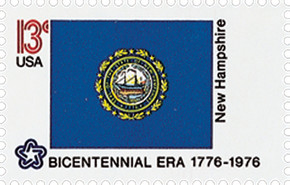
U.S. 1640
1976 South Carolina State Flag
State Flags
American Bicentennial Series
• First time a sheet 50 had all different stamp designs
• Part of the American Bicentennial Series
Stamp Category: Commemorative
Series: American Bicentennial Series
Value: 13¢ First-class postage rate
First Day of Issue: February 23, 1976
First ... more
U.S. 1640
1976 South Carolina State Flag
State Flags
American Bicentennial Series
• First time a sheet 50 had all different stamp designs
• Part of the American Bicentennial Series
Stamp Category: Commemorative
Series: American Bicentennial Series
Value: 13¢ First-class postage rate
First Day of Issue: February 23, 1976
First Day City(s): Washington, DC
Quantity Issued: 8,720,100 (panes of 50)
Printed by: Bureau of Engraving and Printing
Printing Method: Photogravure
Format: Sheet of 50
Perforations: 11
Why the stamp was issued:
The United States Postal Service celebrated the American Bicentennial with a full pane of the Union’s fifty state flags.
About the stamp design:
South Carolina is a simple design with a dark blue field with a white palmetto tree in the middle and on the left upper side is a white crescent moon. The crescent mood came from the cap insignia soldiers wore during the American Revolution. The palmetto tree also came about because of the American Revolution. Colonel William Moultrie flew the flag in the defense of a new fortress on Sullivan’s Island and the fortress survived due to the palmetto trees.
About the printing process: Printed by the Bureau of Engraving and Printing on their seven-color Andreotti gravure press (601) which was their work horse for multicolored stamps.
About the American Bicentennial Series:
In the 1970s, America celebrated its 200th anniversary with hundreds of national events commemorating the heroes and historic events that led to our nation’s independence from Great Britain. The U.S. Postal Service issued 113 commemorative stamps over a six-year period in honor of the U.S. bicentennial, beginning with the American Revolution Bicentennial Commission Emblem stamp (U.S. #1432). As a group, the Bicentennial Series chronicles one of our nation’s most important chapters, and remembers the events and patriots who made the U.S. a world model for liberty.
Several of the stamps honored colonial life – craftsmen and communication. Other stamps honored important battles including Lexington and Concord, Bunker Hill, and Saratoga. Significant events such as the Boston Tea Party, the meeting of the First Continental Congress, and the Declaration of Independence were featured as well. The stamps also honored many significant people such as George Washington, Sybil Ludington, Salem Poor, and the Marquis de Lafayette.
Many of the stamps feature classic artwork. For instance, the set of four souvenir sheets picture important events recreated by noted artists such as John Trumbull. The Bicentennial Series also includes an important US postal first – the first 50-stamp se-tenant – featuring all 50 state flags. The format proved to be popular with collectors, and has been repeated many times since.
The American Bicentennial Series is packed with important US history – it tells the story of our nation’s fight for independence through stamps.
History the stamp represents:
On May 23, 1788, South Carolina ratified the Constitution, making it America’s eighth state.
Before European settlement, more than 30 Indian tribes lived in the area that became South Carolina. The main tribes were the Catawba, Cherokee, and Yamasee. These Indians built semi-permanent log homes, and the majority raised crops.
A Spanish expedition led by Francisco Gordillo explored the Carolina coast in 1521. In 1526, Lucas Vásquez de Ayllón established the first European settlement in what would become the United States. Historians believe the settlement, named San Miguel de Gualdape, was located in the Winyah Bay region of South Carolina. Ayllón brought 500 men, women, and children from Santo Domingo Island to establish the colony.
The English claimed ownership of all North America during the early 1600s. However, no attempt was made to settle the South Carolina area until 1663. That year, King Charles II granted a charter to eight English noblemen known as the lords proprietors. The lords proprietors sent settlers to America in 1669. In 1670, at Albemarle Point, they established the first successful, permanent white settlement in South Carolina. The colonists soon moved to Oyster Point in 1680, naming their settlement Charles Town. In 1783, the spelling was changed to Charleston.
Many important battles of the War for Independence were fought in South Carolina. Much of the fighting was for control of Charleston. Colonial victories at the battles of Kings Mountain on October 7, 1780, and Cowpens on January 17, 1781, turned the war against the British. In 1781, troops under General Nathaniel Greene and the South Carolina militia drove the British out of South Carolina. The British evacuated Charleston in 1782. In total, 137 battles were fought in South Carolina.
South Carolina ratified the Articles of Confederation on July 9, 1778. On May 23, 1788, it became the eighth state of the Union by ratifying the United States Constitution.
LessPlease Try Again
This webpage is experiencing a large amount of traffic. Please try again later.
Please Try Again
This webpage is experiencing a large amount of traffic. Please try again later.
Please Try Again
This webpage is experiencing a large amount of traffic. Please try again later.

Most Orders Ship
within 1 Business Day
90 Day Return Policy
Satisfaction Guaranteed
Earn Reward Points
for FREE Stamps & More











